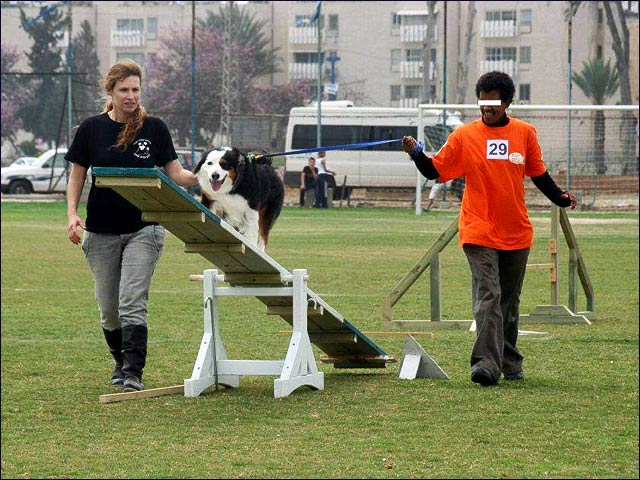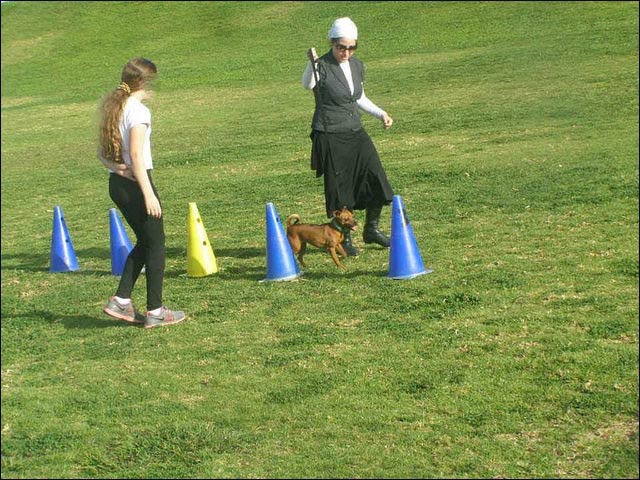By Avigayil Kadesh
Every year, about 1,000 Israeli children and teens with special needs or at-risk behavior are going to the dogs – Dogs for People, that is.
This unique therapeutic and educational model uses canines rescued from streets or shelters to make a measurable difference in young lives in 13 Israeli cities.
“It’s a kind of circle in which each part develops with the other,” explains Asia Pavis, who runs Dogs for People with trainer Paul Elmakes. “We save dogs, rehabilitate them and train them to be therapy dogs, then we take them to youth who develop a deep connection with the dogs, and through that the kids work on themselves.”
In order for the dogs to respond to commands, the children must learn how to handle them assertively yet calmly.
“They have to find this middle place that is the right way to treat the dogs, because the dogs will only listen that way,” Pavis says. “Once they find that balance, it serves them well in all aspects of their lives.”
Every week, all 60 dogs head out from the kennel in the small moshav of Beit Ezra with their guides to lead 70 activities in hostels, schools, kindergartens and community centers in 13 cities. Several times a year, Dogs for People holds agility competitions where the kids can show off what their dogs have learned.

A Dogs for People agility competition in SderotBecause Beit Ezra is located between Ashdod and Ashkelon, near the border with Gaza, some of the young clients need help conquering symptoms of post-traumatic stress due to rocket fire in their hometowns.
The story of Benny
One eight-year-old boy, whom we’ll call Benny, had developed deep fears after his house was hit more than once by missiles from Gaza. Pavis says he couldn’t even go to the bathroom alone, and had difficulties at school.
Dogs for People didn’t seem like a logical choice to help Benny, because he was also afraid of dogs. But they started him with one of the smallest mutts and let him progress at his own speed.
“He went on to bigger and bigger dogs as he learned to overcome his fear, and used those same techniques to overcome his social fears and his fears of bombings,” says Pavis. He even won a gold medal in one of the agility competitions.
When Benny was 12, his community once again was targeted by rockets. “That was this kid’s big test, and it was amazing to see how he managed and controlled his fears,” says Pavis.
Kids with ADHD and autism
Elmakes is often asked to bring Dogs for People to children who have autism and other mental disabilities, says Pavis.
For autistic children who have trouble expressing themselves verbally, the dogs have a magical effect. “We see that children who didn’t speak a word are starting to speak to the dogs,” says Pavis. “The dog gives them a reward and motivation to keep trying to reach out and connect and not stay in their bubble.”

Agility trainingTeens who are working through other issues with the help of Dogs for People are often recruited as volunteers with special-needs children.
“These youth, who have been unsuccessful in school and life, really connect to the kids with special needs,” says Pavis. “The program benefits each participant, because no matter where you come from you always have something to give back.”
One example is “Tanya,” who suffers from attention-deficit hyperactivity disorder. When she turned 11, her parents bought her a dog and approached Dogs for People to help motivate her to concentrate on a worthwhile activity.
“With time, she became pretty good at handling her dog, and competed in our agility competitions. She became very enthusiastic about the training and very active in every volunteer area she could,” says Pavis. “Now she is 16 and is a guide herself -- one of our best. Using the tools she got here, she’s able to be a leader in other parts of her life, too.”
Breed doesn’t matter
Dogs for People grew out of Elmakes’ work as a dog trainer. He discovered early in his career that a pet dog’s discipline problem cannot be solved without training the entire family to model the proper behavior for their pooch.
“The more he worked with families and kids, the more sure he was that dogs can be used as a therapeutic tool,” says Pavis. “He started some groups for youth at risk and autistic kids, voluntarily at first, to find out for himself what works and what doesn’t.”
All the positive outcomes that the guides see result from the unique relationship each child builds with these mixed-breed animals that had previously been abandoned, says Pavis, who is a trained social worker.
“What matters is not the breed, but how tolerant and easygoing the dog is, so that we can take them to activities without any risk to participants,” she says. “The dogs are the main therapists in this relationship.”
Pavis says half the organization’s NIS 1.7 million annual budget comes from the government, and the other half from donations. The non-profit organization works with the Israeli ministries of health and social welfare, local authorities and national organizations such as Kedum Noar, AMEN, the Israel Association for Community Centers and the Karen Karev Foundation.